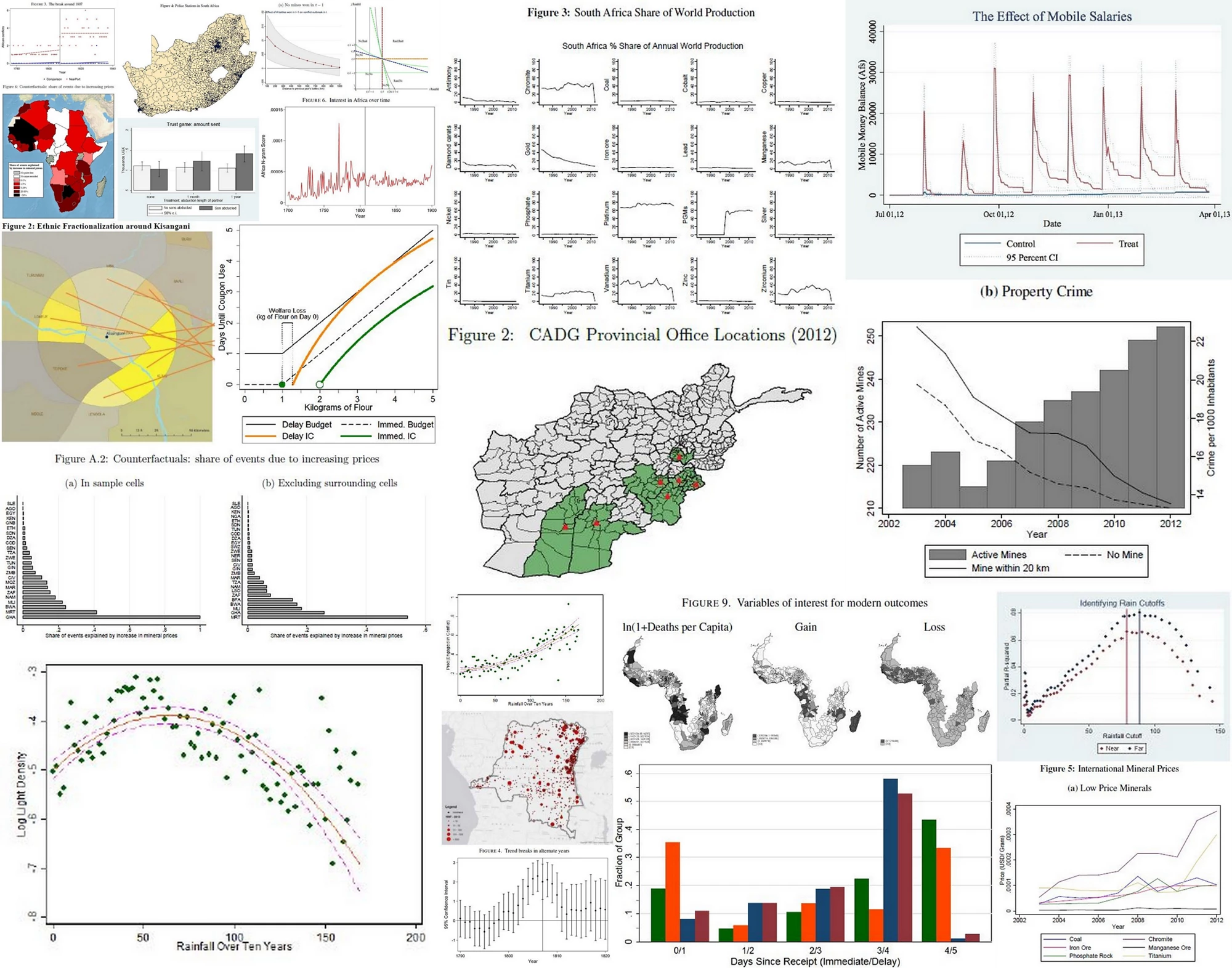
Yesterday closed the second Annual Bank Conference on Africa, this year with the theme Confronting Fragility and Conflict in Africa. Over two days, we heard about 50 papers on causes, consequences, and interventions to interrupt conflict. We also heard presentations of a range of impact evaluations and lab experiments to test policies and understand mechanisms in post-conflict environments. Below is a (non-exhaustive!) run-down of papers, along with some commentary. Almost all the papers are available at the conference site. We’ve tagged #RCTs and Lab-in-the-Field (#LITF) papers.
The Big Picture
- Ted Miguel gave a keynote in which he focused on three principal papers: A recent review (Burke et al 2015) demonstrates, across dozens of studies, a clear positive relationship between rising temperatures and increased conflict, with Africa among the regions likely to be most affected in coming years. At the same time, Burgess et al (2015) show how road expenditures in Kenya were dramatically higher in districts with the same ethnicity as the president, a relationship that is significant during Kenya’s autocratic periods but not its democratic periods, suggesting that democracy can mitigate ethnicity-related violence. To round out the story, Fetzer (2015) shows that a public employment program in India mitigates the relationship between adverse productivity shocks and conflict. So, yes on democracy and social protection programs.
- Axbard et al. use variation in international mineral prices and within-country time and geographic variation to show that when a mine opens in South Africa, crime doesn’t increase. But you may not want to be around when the mine closes.
- Berman et al. use world mineral prices (apparently the second-most popular instrument at the conference, after rainfall) and data from across Africa to suggest that rising mineral prices are associated with higher country-level violence.
- Adhvaryu et al. demonstrate how resource accumulation (measured via rainfall) has a net positive effect of conflict despite competing component effects: greater opportunity cost of conflict, but also more to fight over and more resources to fund a militia.
- Imas et al. find higher present bias among people directly exposed to violence in the DRC, randomly assigning the possible redemption data of coupons at a grocery store. #RCT
- Blumenstock et al. find that in a high risk environment (Afghanistan), people prefer cash over supposedly safer mobile money, since everyone accepts cash, all the time. They vary encouragement to take up mobile money (through default salary payments). #RCT
- Liberians who experienced greater violence during their civil war are more hospitable towards Ivorian refugees, particularly those with health problems or who are fleeing direct violence (Harman & Morse). #LITF
- Chris Blattman (et al.) showed that cash grants to “criminally-engaged Liberian men” had positive effects on income and crime (i.e., less crime) but they faded. When combined with cognitive behavioral therapy, the package had enduring impacts (at least a year). #RCT
- A community reconciliation program in post-war Sierra Leone (evaluated by Cilliers et al.) boosts forgiveness, trust, and social capital, but increases depression at the individual level. #RCT
- Comparing former soldiers in Uganda to non-soldiers (and arguing for a relatively random selection process), Bauer et al. use games to show former soldiers are more cooperative. #LITF
- Do peacekeeping operations reduce conflict? Hegre et al. run a series of simulations that suggest they do.
- You know those three-hour consumption surveys? Pape & Mistiaen show how rapid consumption surveys (under 60 minutes) that ask about few items per household but all items across households can deliver reliable aggregate poverty levels, particularly useful in fragile countries.
- How do you sample in war zones? Himelein et al. test several methods in Mogadishu. Which does best depends, but the Mecca method (randomly select points and walk in a set direction from them, e.g., towards Mecca) does well; the random walk method (select a point and have all enumerators walk in different directions, continuing in the same direction after each interview) does poorly.
- In conflict data, a zero can mean peace, or it can mean deaths under a certain threshold; it can mean a brief cessation of conflict or one year of peace among many. These nuances can mean that a Poisson model beats out a Probit or Logit model (Dunne & Tian).
- Etang-Ndip et al. demonstrate in northern Mali how a combination face-to-face survey and follow-up mobile phone interviews can track internally displaced persons.
- Extreme rain and drought both boost livestock theft in Kenya: raids driven by resource scarcity but also by weather that makes it easy to carry out a raid (Ralston).
- How does conflict between farmers and pastoralists affect state revenues in Nigeria? McDougal et al. use the anticipation of whether or not Sharia law will be adopted in the neighboring state as instrument, and estimate that states have lost enormous revenue (ranging from 22-75%).
- The downside of social capital: Weekly community service groups were politicized in the run-up to the Rwandan genocide. Higher rainfall (meaning more cancelled meetings) significantly reduced civilian participation in the genocide (Bonnier et al.).
- Civic participation program in Rwanda lowers reported satisfaction with government services and knowledge of government affairs, potentially by encouraging people to speak their minds (Nichols-Barrer et al.). #RCT
- A program gives a grant in Sierra Leone and randomly varies who manages it – traditional village elites versus randomly selected households. Elites manage the projects better and don’t capture more (Turley et al.). #RCT
- James Fenske took a long view, showing how shifts in the slave trade in the early 19th century affect intra-ethnic conflict in Africa today.
- In Ghana, higher police salaries translated into more time in traffic stops and higher bribes paid (Foltz & Opoku-Agyemang), measured using difference-in-differences before and after a salary increase, comparing bribes paid by the same trucks in and out of Ghana.
- “Members of ethnic groups exposed to greater historical missionary activity [in 19th-century Nigeria] express significantly less trust today,” using Afrobarometer trust measures (Okoye).
- How do political elites use armed groups to mobilize civilian participation in violence? Rogall uses rainfall interacted with distance on dirt roads as an instrument and shows that one additional armed-group member mobilized 7.3 more civilian perpetrators in the Rwandan genocide.
- “Repression may reduce overall dissent, but cause dissent that occurs to become more violent,” demonstrated with descriptive data from across Africa (Wallsworth).
- Pre-natal trauma leads to lower contributions in a public goods game among 6-14 year olds in Northern Uganda. And yes, Cecchi & Duchoslav test and rule out a bunch of competing hypotheses. #LITF
- Rwandan violence in the 90s (the genocide, the civil war, etc.) is associated with a 22% drop in schooling attainment, with much bigger effects for girls. Difference-in-differences (Guariso & Verpoorten).
- If a woman is exposure to civil war in utero, her children have lower height-for-age scores. Evidence from Liberia’s civil war using district variation in exposure (Sonne & Nillesen).
- War is also bad for children’s height-for-age score if exposed directly. Evidence from the Ethiopia-Eritrea conflict using Young Lives data (Weldeegzie).
- State-led violence in Zimbabwe is associated with lower height-for-age scores, using Demographic & Health Surveys (Shemyakina).
Fiscal Policy and Economic Activity!
- Rebels in Côte d’Ivoire cut the export tax on cocoa. As a result, farmers increased acreage and labor, and a nice triple-difference estimation shows they have higher expenditures (Soumahoro).
- Electronic sales registry machines boost tax payment by 20% in Ethiopia, by reaching firms that previously evaded taxes (Ali et al.).
- Using a census of registered firms in Côte D’Ivoire, Klapper et al. show that unrest that began in 2000 was associated with higher firm exit, lower firm entry, and lower TFP (especially for foreign owned firms).
- How does government spending relate to falling commodity prices and conflict? Using cross-country African data, Aguirre & Calderón argue that a countercyclical fiscal response reduces the chance of conflict.
- Violence is bad for business: Electoral violence in Kenya lead flower exporting firms to operate at a loss and workers to lose more than 3 weeks of earnings. Triple-difference estimates from Ksoll et al.
- With cross-country data, Calì & Mulabdic suggest that a rise in exported commodity prices is associated with more (and longer) conflict, but that intense trade with neighbors is associated with less.
- Food prices can simultaneously increase and decrease violence: Rising consumer prices increase armed conflict in food-deficit areas, while higher producer prices reduce civil conflict in food-surplus areas, using global food price shifts (McGuirk & Burke).
- In case you doubted that informal is normal, as much as 97% of trade between Algeria and Mali is informal, argue Benassi et al. as they seek to measure the difficult-to-measure.
- Drought leads to increased violence against women. When the shock affects income asymmetrically across partners, it is associated with violence for the first time in the marriage (Cools et al.).
- In the DRC, conflict is associated with higher infant mortality for girls but not boys (Dagnelie et al.).
- Berg et al. use lab games to test for co-ethnic preferences in Nairobi and finds very little evidence, even in election periods. Given inter-ethnic violence, this suggests that ethnic divisions may be driven by political organization rather than individual preferences. #LITF
- Surveys of both voters and politicians in Kenya suggest that voters perceive violence perpetrated by politicians negatively (even within their own ethnic group) whereas politicians don’t realize that. Evidence from vignette experiments (Rosenzweig). #LITF
- Commuters in mini-vans in Ghana were randomly exposed to different partisan radio stations. Any partisan radio increased reported political interest, but exposure to radio opposed to listener preferences dampened political engagement (Conroy-Kutz & Moehler). #LITF
Finally, there was a panel on what we’ve learned about the economics of Ebola. One of us (Dave!) walked through the promise and pitfalls of estimating the economic impact of Ebola using computable general equilibrium models (Lesson: Any time you report multiple estimates, everyone will immediately forget the less dramatic estimate). Rachel Glennerster showed that food aid in Sierra Leone modestly lowered prices (“ Going from 0-100% of people receiving food assistance during Ebola crisis reduced food prices by 5-10%”). And Lily Tsai presented results on how distrust of government may have contributed to the epidemic’s spread in Liberia, but how community outreach under government auspices increase take-up of preventative measures. Chris Blattman wrote up some reflections on the discussion.
Wrap up
The literature on conflict and on economic issues in conflict and post-conflict environments is growing fast, drawing on a broad mix of methods and data. We were particularly struck by the growth of lab-in-the-field work. It will be interesting to see how can feed into evidence-based policy to prevent conflict and mitigates its impacts in the future.




Join the Conversation